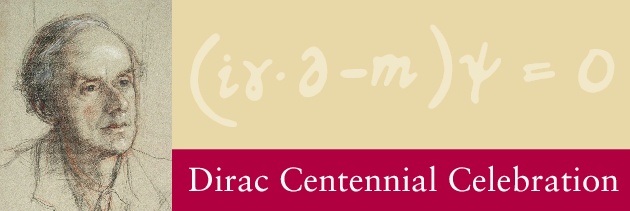 |
| (portrait by R. Tollast, 1963; reproduced by permission of the Master and Fellows of St. John's College, Cambridge) |
| Biographical and Research Highlights |
| Biographical highlights:
Paul Adrien Maurice Dirac was born in Bristol on August 8 1902. He studied engineering and then Mathematics at Bristol University between 1918 and 1923. He became a research student in Cambridge under the supervision of Ralph Fowler in 1923, receiving his PhD in 1926, by which time he was already a renowned theoretical physicist. He was awarded a fellowship of St John's College, Cambridge in 1927. The first edition of his celebrated textbook "The Principles of Quantum Mechanics" was published in 1930, the year in which he was also made a fellow of the Royal Society 1930. He was appointed to the Lucasian Professorship of Mathematics in 1932 and received the Nobel Prize (with Schrodinger) in 1933. After retiring from Cambridge in 1969 he took up a Professorship at Florida State University, Tallahassee, Florida. Dirac died in Tallahassee on 20 October 1984. Research highlights: Seminal contributions to complete theory of quantum mechanics (1925-26): While still a graduate student Dirac gave the first complete formulation of quantum mechanics, based on Heisenberg's matrix mechanics. Dirac introduced the formalism and notation that has formed the basis of almost all subsequent work. Foundations of quantum field theory (1927): Dirac was the first to apply the principles of quantum mechanics to electromagnetic radiation, thereby providing a consistent setting for the original ideas of Planck. He subsequently extended this to the description of electrons and other particles in terms of fields. Quantum Field Theory is the basic framework for the description of elementary particles and their forces as well as having widespread application in condensed matter physics. Statistical mechanics of fermions - Fermi-Dirac statistics (1926): Dirac (and, independently, Fermi) understood why two or more spin 1/2 particles (such as electrons) cannot coexist in the same quantum state. This is a fundamental principle that explains the structure of atomic orbitals and hence much of chemistry. It is also crucial for understanding the special properties of metals and many other aspects of condensed matter physics. Relativistic equation of the electron (1928): The synthesis of quantum mechanics with special relativity in Dirac's celebrated equation for the electron is his most famous discovery. With great economy and mathematical elegance his equation explains the fact that electrons have spin 1/2 and also leads to the prediction of the existence of a particle of opposite electric charge to that of the electron. Prediction of anti-matter - the positron (or anti-electron) (1931): Dirac eventually realized that the particle of opposite electric charge must have the same mass of the electron and must be a new form of matter. This `anti-electron', or positron, was soon discovered experimentally. However, Dirac's discovery is far more general and predicts the existence of antiparticles for every particle. Origin of the `path integral' formulation of quantum mechanics (1933): Dirac's early work on the Lagrangian formulation of quantum mechanics eventually led, in the late 1940's, to Feynman's `sum over histories' (or `many worlds') description of quantum mechanics and quantum field theory. Mass renormalization and radiation reaction in electron theory (1938): Dirac realized that quantum field theory has apparent pathologies that need to be fixed up by taking into account the effect of the radiation emitted by a particle on its mass. This was a predecessor of the `renormalization' procedure that enters into modern quantum field theory. Dirac disapproved of renormalization and considered its necessity to be a symptom of the failure of quantum field theory. Theory of magnetic monopoles (1931, 1948): Dirac investigated how magnetic charges can enter into electromagnetic theory in addition to the familiar electric charges. There is still no experimental evidence that such objects exist in nature although they are predicted to exist in many modern unified field theories. Dirac's description of the magnetic monopole is the progenitor of the wealth of topological ideas in quantum field theory and string theory that have come to dominate modern developments. Constrained Hamilton dynamics (1958-61): Dirac's formulation of the classical and quantum mechanics of constrained systems has found widespread application in modern theoretical physics. It is one of the key ingredients in Yang--Mills theory, which describes all of the non-gravitational forces, and in theories of quantum gravity and string theory. Theory of relativistic membranes (1962): Dirac studied the properties of an extended membrane-like particle (analogous to a soap bubble) in order to explain the experimental existence of a the mu-meson. He established the mathematical formalism required for describing extended objects moving through space and time in a manner that is consistent with special relativity. In 1969 Nambu and Goto formulated a theory of a relativistic string that is based on the same mathematical ideas and which forms the basis of string theory. Cosmological problems of large numbers and varying `constants' of nature (1937, 1973-75): Dirac's fascination with the large numbers that enter into cosmology led him to postulate that the so-called constants of nature, such as Newton's constant which determines the strength of the gravitational force, actually vary with time as the Universe evolves. Although experimental evidence is lacking for this proposal it has influenced a number of important ideas relating cosmology to the the physics of elementary particles. |